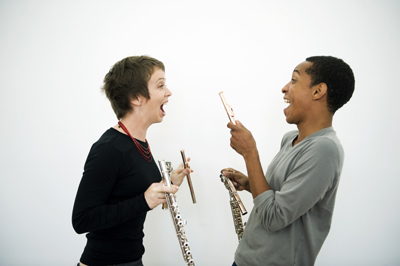| « Review: St. Vincent @ Metro & Millennium Park 6/7-6/8/2009 | More Than Just Ribs at Ribfest » |
Feature Thu Jun 11 2009
ICE Bring Xenakis and "Aural Assault" to Chicago
The Greek contemporary classical composer Iannis Xenakis (1922-2001) is sometimes written off (in the manner of Karlheinz Stockhausen, John Cage, Morton Feldman, et al) as a composer who has contributed great ideas and concepts to the dialogue of music, but who composed music that "regular people" don't actually enjoy listening to. Fortunately, the International Contemporary Ensemble (ICE) breaks through this false barrier like the Hulk through a rice-paper wall. Listening to the 75-minute performance on June 4 at the Museum of Contemporary Art felt neither like a superhuman test of endurance, nor like aural homework that was "good for us" but unpleasant. Instead, we were treated to music that was vibrant, passionate, and almost visible in its spatial movement throughout the concert hall. Far from a stuffy evening of "abstract" music, the group was more than happy to frame its work in the language of modern rock, experimental, and noise bands, describing what it does, gleefully, as "an aural assault on the Windy City."

The members of the International Contemporary Ensemble (ICE). (Photo by Liz Linder.)
Xenakis is not a common name on most standard programs of classical music, or even programs of avant-garde "new music." For starters, his music, which is steeped in aspects of higher mathematics, quantum theory, mystic/shamanic elements, and architectural concepts (Xenakis was an assistant of Le Corbusier, designing the legendary Philips Pavilion for the 1958 Worlds Fair in Brussels), does not conform to standard Western notions of beauty or melodicism. Furthermore, live performance of just about any of Xenakis' music requires astonishing, almost super-human virtuosity from its performers, yet at the same time, the result of a passionately-played Xenakis composition is still a Xenakis composition — full of lurching rhythms, bent notes, frantic runs, controlled dissonances, and melodic lines that are composed with processes drawing from quantum mechanics, game theory, string theory, and other forms of indeterminacy, none of which exactly makes it a candidate for general accessibility or inclusion on those "Relaxing Classical!" compilations (even John Cage's prepared piano music has been packaged as "ambient music for relaxation" on occasion). It's a safe bet that you won't be able to hum most Xenakis compositions after hearing them, but that's not to say you shouldn't try (listening or humming).
The evening's program, simply titled Xenakis, was acutely aware in its five pieces of the multiple considerations of space (the field of performance) and density (size of the group performing each piece), with ensembles ranging from solo (conductor/percussionist Steve Schick's masterful take on Psappha, a rare composition for solo percussionist) to groups of 11 or 12 (larger pieces like Èchange and Palimpsest). The ensemble was arranged in different permutations throughout the stage for each piece, with the performers of Akanthos huddling in a tight circle around soprano vocalist Tony Arnold, and Palimpsest arranging the ensemble in a straight line across the stage, alternating string players with wind players to emphasize instrument-to-instrument interactions, rather than instrumental "sections" arranged in standard orchestra formation. Most striking spatially was the finale, O-Mega (a composition from 1997, and Xenakis' final composition before his death in 2001), which grouped the ensemble into its four major instrumental components (piano/percussion, strings, woodwinds, and brass) and placed each orchestral "element" onto radically different parts of the stage, with the brass and winds actually flanking the audience in the exit walkways. Here, the musical lines jumped all over the sound field, volleying huge blocks of uncommonly melodic, almost majestic, fragments of melody between the four sections.
ICE in dress rehearsal with vocalist Tony Arnold, performing Xenakis' Akanthos. (Photo by ICE.)
Much must be said of the soloists on many of the pieces. Soprano vocalist Arnold wound her supple, passionate vocals around the keening wail of the strings, bending her notes to intertwine with woodwind instruments, essentially using her voice as an instrument, while still firmly establishing her position as soloist, never losing her instrumental voice amidst the melee. Similarly, Joshua Rubin's bass clarinet solo in Èchange defied the conventional limitations of the instrument, jumping between soft, roiling tones and volcanic, split-tone dissonances that could send a whole generation of Eric Dolphy imitators back to the woodshed. And Corey Smythe's thunderous piano work throughout Palimpsest brought enough applause from the audience to summon him back to the stage three times.
In truth, the entire ensemble's execution of the material was intuitive and meticulous. From low strings to the highest piccolo notes, there was a fleetness of technique that allowed the group the freedom to pursue the impossibly complex and rhythmically challenging compositions at what seemed like a fast clip — Palimpsest, in particular, was played at a heart-stopping velocity, with musical lines darting from player to player in erratic patterns across the stage, creating effects like electric current jumping through the air between two wires.
Through the band's special Xenakis-centered web site, and its "Tracing Xenakis" podcast, ICE members provide passionate anecdotes about their first experiences with Xenakis' music (and in many cases, "contemporary" music in general), gently guiding new listeners into the potentially scary, off-putting world of abstract sound. My favorite is a story told by a member of the group who once asked a music professor about Xenakis' music, only to have the professor invite the student over to his house to play him a record of a Xenakis piece, ostensibly to show the student what "BS" the music was. The student, hearing the composition (Metastasis, a piece for orchestra that Xenakis composed in part by using the architectural plans of his design for the Philips Pavilion) for the first time, vividly describes the sound of the piece (a performance of which is overlaid on the anecdote for emphasis) and his feelings while listening. The professor looks at him, thinking he has "cured" the student of his interest in avant-garde music. Instead, the storyteller says "I was shaking uncontrollably from the greatness of the piece, and I blurted out 'that is the greatest music I've ever heard!'" This level of enthusiasm and passion, coupled with a willingness to share this gift with anyone interesting in giving it a try, forms the core of ICE's goal as an ensemble.

ICE flutist and Executive Director Claire Chase (left) with ICE flutist Eric Lamb. (Photo by Liz Linder.)
After the dress rehearsal, I sat down with three members of the ensemble: flautist and Executive Director Claire Chase; clarinetist Joshua Rubin; and the conductor/soloist for this concert, Steven Schick, to talk about ICE's role in the contemporary music community, and the importance of growing a local community of committed listeners.
ICE currently splits much of its time between New York and Chicago, its two primary bases of operation. Says Chase, "We split our season pretty much straight down the middle. We were founded here in Chicago, in 2001, and the original idea of the organization was to actually have three chapters: one in the Midwest, one on the East coast, and one on the West coast. We'll probably open a chapter in a city yet to be named on the West coast around our 10th anniversary, in 2011."
Although the ensemble performs all over the country (having played shows this season in Boston, South Carolina, and Baltimore) and on several continents, the group relishes using its twin bases as a path to built grassroots support for both the ensemble and contemporary music in general.
"This multi-city location and arrangement has allowed us to self-produce a lot of our own projects. We don't have to rely on venues and presenters that tell us what they want to program," says Chase. "People told us we'd be crazy to try to run a worldwide contemporary music ensemble with local chapters, but it's really worked out for us, and it's worked out from a funding standpoint, too, because we are able to build a community around what we do, and we are able to fundraise around what we do geographically. For us, it's an alternative to the touring model, where you workshop five programs, you shop them around to a million different places, and you never really get a chance to cultivate a community around what you do, which is a huge part of ICE's mission." The group has played a variety of Chicago locations in its 2008-2009 season, including the Museum of Contemporary Photography (600 S. Michigan), Uncommon Ground coffee shop (1401 W. Devon), and the campus of Northwestern University in Evanston. Their small-unit pieces have included duets for clarinet and percussion, an evening of compositions for toy piano, and an ongoing series focused on performances of the work of composers under the age of 35.
"We give about 50 concerts a year," says Chase. "Of those, I would say about 25 are unique projects, so we work with a lot of different composers. Xenakis is certainly the most massive thing we are going to take on this year, and is going to continue into the next season. One of the really cool things about ICE and the structure of it is that you have 31 people in the group. We do a handful of concerts each year that involve between 25 and 30 people. We can expand to be orchestra-sized, but the rest of the time, we can also generate smaller projects. We have a monthly series here in Chicago in small venues, places like the Velvet Lounge, Katarina's, the Green Mill, and in New York, we play little places like The Tank and The Stone. We have several events per month that are unique programs, different collaborations with different composers. Xenakis has been the highest profile thing we've done, and we've really put the ICE marketing machine behind it, but also our aesthetic net is cast really wide. We're actually opening an opera in Greenwich...we're starting the rehearsals the day after this performance. I'm doing a Steve Reich concert two days after that, and we're doing a collaboration with DJ Spooky the day after that."
The members of ICE during a dress rehearsal at the MCA in Chicago. (Photo by ICE.)
Rubin, ICE clarinetist and creator of the "Tracing Xenakis" podcast, says that gaining traction with new listeners is best accomplished by spreading out into multiple media. "I think we looked at this project as a great opportunity for us to begin this kind of model of multiple streams of information, doing the podcast and the continual updates on the website. Over time, we started to find more sympathetic people, people who were interested in this subject who could come into our sphere, enlarging that sphere and getting more and more people involved in different ways to engage potential listeners on a lot of different levels — the way that Xenakis was involved in all these levels of math, and architecture, and theater, and so forth. He was sort of a metaphor for this project in a lot of ways."
Conductor/percussionist Schick, a long-time veteran of the contemporary music community and professor of music at both the University of California, San Diego, and at the Manhattan School of Music, is delighted at the fact that contemporary music is gaining popularity with a new generation of listeners. "The one thing you never hear anymore that you always used to hear is, 'what a horrible situation we're in.' You know, 'it's horrible, nobody cares, nobody understands [contemporary/avant-garde music],' and that's just not true these days.
"We're originally from San Diego...Claire is, and I'm a transplant, and the notion of the surf being up is part of our culture, and, really, the surf is up right now. There's more music, more interesting music, more available music, more people who know about it than ever before. All you have to do is look at the American orchestra scene to see what's going on. An orchestra that doesn't play contemporary music has got financial problems. When you look at what Minnesota is doing, for example, or San Francisco, the success of those enterprises is completely and directly linked to the extent to which they were interested in engaging contemporary music."
Schick is also understandably enthusiastic about the growth of contemporary music's fan base from a practical standpoint, too. "It's not just altruistic," he reminds me, "there is a life here, and there is a way to make a life. You don't have to be a martyr now...there's a way of doing it, and living it."
As we end our chat, Chase reminds me of what sets apart ICE from many other contemporary ensembles...its engagement with the audience. "It just comes down to a conversation. We love to have a conversation with our audience; we love to have a conversation with each other. That's the meaning of contemporary music...contemporary, as in the Webster's Dictionary definition of it, is something that is coming into being. It's a process, and that's what we're engaged in, a process. The definition of what we're doing is constantly shifting, and that's a conversation we love to have with an audience."
For more information on upcoming Chicago performances by ICE, go the ensemble's web site.
















Alex Hough / June 11, 2009 1:39 PM
Great piece on a great ensemble. It's one of my gravest sins that I wasn't able to attend this concert. Thanks for giving me a little bit of the experience secondhand.